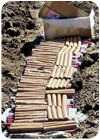
In the 1960s, our company, Cutter & Dad Drilling Co., was abandoning leaking oil wells near Chanute, Kan. We were contracted to remove the defective and leaking steel casing in some 400 wells for Brundred Oil Co. We were to remove the casing with holes in it and replace it with new casing or plug the wells with cement.
We would run a string of 1-inch steel pipe inside these wells to the bottom, usually around 800 feet. This was used as a guide to be able to stab the casing that remained in the well once we unscrewed from it. Then we would pull up hard on the 2-inch or 4-inch steel casing, and it hopefully would unscrew somewhere deep in the well. We would replace the casing that had holes in it and apply high pressure to the casing. If it still leaked, we would remove the installed casing, go in the hole with a left-handed string of casing and left-handed tools, unscrew more casing and replace it with new casing, then repeat the testing process again.
If it was impossible to refurbish the well, we were required to plug it. In those days, you were required by the Kansas Oil and Gas Commission to be a registered well plugging contractor, which we were.
The Kansas Oil and Gas Commission people usually required that one of their authorized representatives be on site, and that all casing be removed from the wells to 600-plus feet and then neat cement pumped through a tremie pipe, usually to a depth of at least 600 feet back to the top, below plow level.
To remove the casing to 600 feet sometimes required many hours. If the wells had no casing, we were required to drill and clean the hole back to 600 feet. Sometimes, these uncased holes previously had electrical wire with a window weight (a piece of heavy steel to pull the wire down) dropped in them. This wire usually was the original power line to the wells. The farmer's plow would get tangled with the wire, and the well was the easiest way for the farmer to get rid of it. Wire is the second hardest thing to remove from a well because it tends to wrap into a ball around the drill stem or bit, making it hard to remove.
Some of the wells were filled with boulders or railroad ties. Railroad ties are the hardest to drill up because they tend to rotate in the hole, or when you do drill through them, they swell and you have a problem pulling the bit back through them.
If there was casing in the hole, we were allowed to set off an explosive (usually dynamite or nitro gel) in a specially made tin tube with three barbs on the outside, so that when you ran it to near 600 feet, you would pull it back until it caught just below a pipe coupling. Then when blowing the shot (while pulling on the casing with the drill), it would swell the pipe just below the coupling, tapering the threads to a point that they would pull out of the coupling and allow us to remove the casing without doing serious damage to the casing and making it hard to pull out.
Once this was done, we could complete the well plugging process. Sometimes, we would spend weeks on one well, but it had to be done right.
Many of these old oil/gas wells had been drilled in the 1890s and, due to not being properly plugged, they would start leaking oil in a farmer's field and on his crops. In the 1960s, when the oil companies started doing various secondary oil recovery processes, these lost and abandoned wells started appearing and leaking oil more often.
I was 18 years old and usually the explosive shooter, meaning I loaded the specially made can with dynamite, installed the dynamite cap (the igniter) and spliced the cap wire to the shooting cable (shot wire to drop shot and set off the load)

Years ago, dynamite was used to help plug old oil wells. Today, it's hard to buy any kind of explosive without a license.
While dad was cleaning up the site, pulling the casing and running the tremie line in the well, I was checking the shot wire for damage and possible breaks. Then, to check for continuity since dynamite caps only cost a quarter back then, for fun I would place the cap under an oil can to see how far it would fly. It didn't fly at all; however, I never did find the bottom of the can.
Once for fun, I used a piece of dynamite about the size of a 50-cent piece, placed it in a hole one shovel blade deep and covered it up. I hollered at dad, “Fire in the hole!” He said, “Set 'er off,” and I did. You know, it blew a hole in the ground the size of a pickup truck. It took me all day to fill in that hole.
Today, it's hard to buy dynamite, caps or explosives of any kind without a license. Anyway, as they say, “Don't try this at home!”
ND




Report Abusive Comment